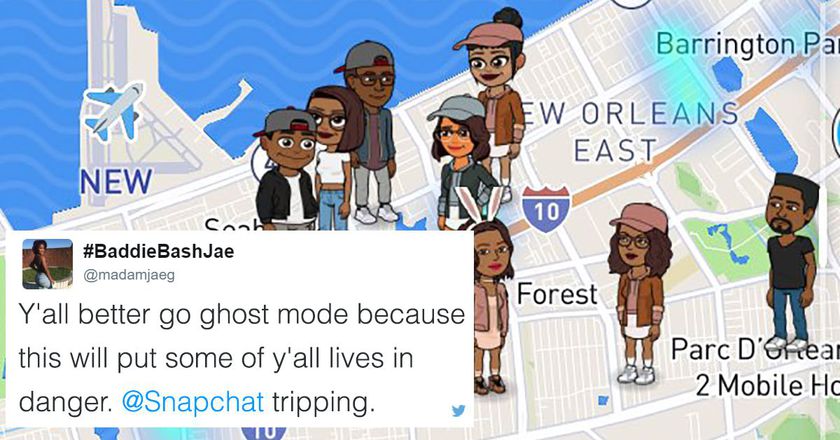- Study Says Most Parents Don’t Use Car Seats In Ride Share Vehicles Like Uber
- This 12-Year-Old Boy Is A Sophomore Aerospace Engineering Major!
- Fire Safety Experts Warn Of Hand Sanitizer Danger After A Mom and Kids Escape House Fire
- Recall Alert: Peaches May Be The Cause Of Salmonella Outbreak, 68 People Ill
- Summer Vacation In The Days Of COVID: Tips To Stay Safe
- How To Safely Grocery Shop During The Coronavirus Pandemic
- Michigan Teen With Vape-Related Illness Undergoes Double Lung Transplant
- Teen Kicks Off Anti-Vaping Campaign From Hospital Bed
- Teenager Receives Life Sentence For Strangling Sister To Death Over A Wi-Fi Password
- Toddler Falls To Death From 11th Deck of Cruise Ship
New Snapchat feature could put kids at risk, warns Brockville police


Map allows users to track their friend’s location in real time
A new map feature of the popular Snapchat photo-messaging application is drawing warnings from Brockville police and privacy experts, who worry predators could use the app to get a dangerous amount of information about your children.
In a video posted to the force’s Facebook page Wednesday evening, Chief Scott Fraser pulls up the new map feature and demonstrates how you can access a user’s specific position.
“Guaranteed, if you have a teenager out there, or younger, they’re using Snapchat on a daily basis,” – Fraser said in the video.
“Protect your family and protect yourself. Take the time and learn about Snapchat.”
Fraser says police haven’t gotten any complaints about the feature, which was released last month. Instead, they’re hoping to educate the public and allow residents to better protect themselves.
How Snap maps works
Snapchat users need to opt in to use the map feature, but Fraser says he’s already heard from many people in Brockville who didn’t realize they’d enabled it.
To see the map, users need to pinch their screen with two fingers and then spread their fingers apart as you would when zooming in on a photo.
The app then shows where you are on a map — right down to the street you’re walking on or building you might be inside — and where all of your friends are.

In the Facebook video, Fraser also shows how you can watch a stranger’s video, if that user has publicly uploaded it using Snapchat’s “Our Story” feature.
Masking your location is a simple fix. All you have to do is click on your avatar or “bitmoji” on the Snap map and switch to “ghost mode.”
Big response to video
Fraser says the video, which has already been viewed more than 200,000 times has started a conversation in Brockville and he’s already heard from a lot of people who thanked the force for bringing the new feature to their attention.
One person contacted Fraser to express their concern that potential burglars might know when you’re away from home. Others were concerns with the possibility that strangers could track the location of their children.
“They’re now are asking these questions and they’re taking an interest,” he said. “It’s great because they’re now opening these conversations with their kids.”
The map can only be viewed by a user’s Snapchat friends, but Fraser says that doesn’t diminish its danger since many kids will accept friend requests from strangers.

“I think it happens way more often then we tend to want to think,” agreed Stephen Sauer, the director of Cybertip.ca, a website run by the Canadian Centre for Child Protection.
“In many cases youth, they feel the need to be wanted and as individuals come in friend requests that kind of fills that need. They may be gaining followers and that increases their status among their friends as well.”
The danger to kids is real
Since the new feature was introduced, Sauer says his organization hasn’t heard about any misuse.
But with the safety of kids at stake, he wants parents to be vigilant.
Sauer says, in the past, predators have become friends with children and then scoured the internet to find information about them and then “utilize that information to make threats against the youth.”
With information like the child’s school or home address so readily available, the potential exists for a predator to use personal information to demand illicit photos or a meeting.
“The child refuses to provide the imagery that they’re requesting and then the individual begins to use the information to say, ‘I know where you live. I know where you are right now and I’m going to come get you,'” he warned.
Here’s what the experts want parents to know
- Set your account and your childrens’ accounts to ‘ghost mode’ so no one can access their location.
- Be aware of what your children are doing online and try out the apps beforehand.
- Advise your kids not to accept friend requests from anyone they don’t know in person.
- Discuss the potential dangers of giving out too much information online.







0 comments